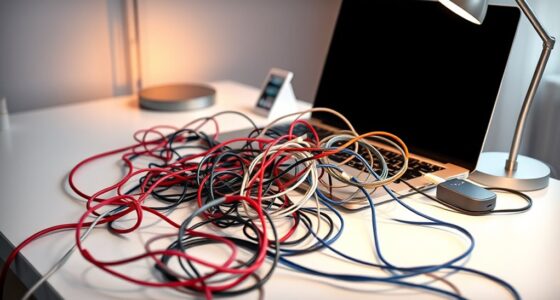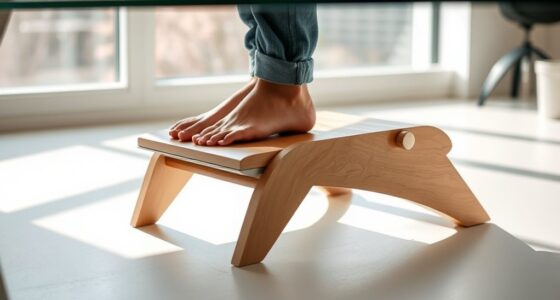To master cable management without drilling holes, you can use adhesive cable clips and hooks to guide cords along walls or furniture, hiding them out of sight. Wrap cables with sleek sleeves or fabric covers for a seamless look. Conceal wires behind furniture, decorative items, or plants for a natural disguise. Installing cable raceways or using under-desk trays helps keep cords organized. Discover more smart tips to hide your cords effectively and effortlessly.
Key Takeaways
- Use adhesive cable clips, hooks, and conduit systems to guide and conceal cords along walls and furniture without drilling.
- Wrap cables with cable sleeves, fabric covers, or DIY fabric/ paper covers for a neat, drill-free organization.
- Hide cords behind furniture, decorative items, or plants to naturally conceal wires without damaging surfaces.
- Install adhesive-backed cable raceways and under-desk management trays to route and hide multiple cords seamlessly.
- Opt for wireless devices and chargers to reduce cable clutter and simplify cable management without hardware modifications.
Using Cable Sleeves and Wraps for a Sleek Look

To achieve a clean and organized appearance, using cable sleeves and wraps is an effective solution. Start by selecting sleeves that match your room’s color scheme for a seamless look, or opt for neutral tones that blend with your decor. When choosing materials, consider flexibility, durability, and ease of use—flexible silicone or fabric options work well for most setups. Color coordinating your sleeves helps hide clutter and makes your space look tidy without drawing attention to cords. Wraps can be used to bundle multiple cables together, preventing tangles and reducing visual clutter. Proper material selection guarantees the sleeves stay in place and protect your cords from damage. With the right combination of color and material, your cables will appear sleek, organized, and unobtrusive. Additionally, incorporating rustic decor elements can complement the farmhouse style while keeping your space neat.
Employing Adhesive Cable Clips and Hooks

Adhesive cable clips and hooks offer a simple and effective way to keep your cords organized and within reach. They’re perfect for managing wires from wireless charging stations, preventing clutter. To maximize their effectiveness, consider these tips:
- Place clips near your power source to easily access and label cables.
- Use hooks to guide cords along walls, keeping them out of sight.
- Combine cable labeling with clips to identify wires quickly, especially when multiple devices are involved.
- Opt for different colors or sizes to differentiate between charging cords, data cables, and other wires.
- Selecting the right cable management tools can improve overall organization and reduce signal interference.
This approach keeps your workspace tidy, avoids accidental unplugging, and makes cable management less frustrating. Adhesive clips are versatile and don’t require drilling, offering a quick, damage-free solution.
Concealing Cords Behind Furniture and Decor

Hiding cords behind furniture and decor is an effective way to keep your space looking clean and organized. Position your devices near furniture to conceal wires, reducing clutter. Use decor integration by placing cords behind bookshelves, cabinets, or decorative screens, making them less noticeable. For wireless charging devices, position chargers near surfaces so cables stay hidden behind furniture, maintaining a sleek look. Tucking cords behind sofas or under rugs can also help, especially if you secure them with adhesive clips or cord wraps. Keep power strips out of sight by placing them behind furniture, and opt for furniture with built-in cable management features. Additionally, incorporating automation technologies can simplify your cable organization process by enabling remote control of device power sources, further reducing visible wires. These strategies create a seamless appearance while ensuring your cords stay out of view and your space remains tidy.
Utilizing Cable Raceways and Channel Systems
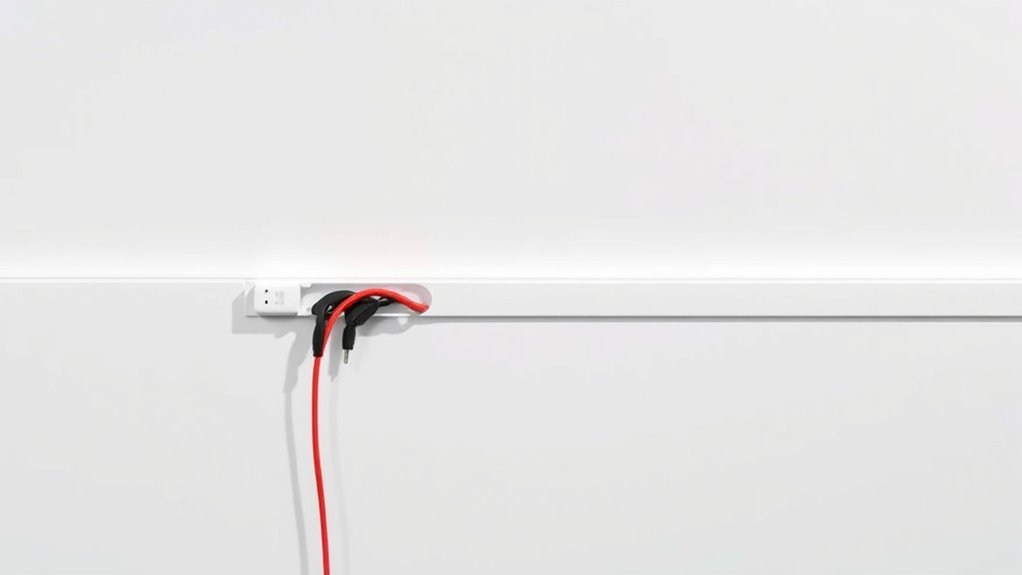
Cable raceways and channel systems offer a practical solution for managing multiple cords neatly along walls and furniture. They hide clutter, protect cables from damage, and create a clean look without drilling holes. When choosing cable raceways or channel systems, consider these key points:
- Size and capacity: Match the raceway to your number of cords for a tidy fit.
- Adhesive backing: Opt for options with strong adhesive to avoid damaging surfaces.
- Ease of installation: Select systems that are simple to cut and assemble.
- Aesthetic options: Pick colors or designs that blend seamlessly with your decor.
- Compatibility with Volkswagen Tuning components: Ensure the cable management solution accommodates any electronic accessories or wiring related to vehicle upgrades or aftermarket electronics.
Using cable raceways and channel systems effectively keeps cords organized, reduces hazards, and enhances your space’s overall appearance.
Creating a DIY Cable Cover With Fabric or Paper

To create a DIY cable cover with fabric or paper, start by choosing materials that suit your space and style. Next, shape your cover to fit your cables comfortably, then secure and finish it for a clean look. With the right approach, you’ll keep your cables organized and hidden effectively. Incorporating flexible materials allows for easier customization and adjustment as needed self-watering plant pots.
Selecting Suitable Materials
Choosing the right materials is essential for creating an effective and attractive DIY cable cover with fabric or paper. You want materials that balance durability and aesthetic appeal, ensuring your cover lasts and looks good. Consider these factors:
- Material durability – Choose sturdy fabrics or thick paper that won’t tear or wear quickly.
- Aesthetic appeal – Pick colors and textures that complement your decor.
- Ease of handling – Select materials that are easy to cut and shape without fraying or crumbling.
- Adhesion compatibility – Make sure adhesives work well with your chosen fabric or paper to prevent peeling or loosening over time.
Crafting the Cover Shape
Once you’ve selected the right fabric or paper, shaping your cover becomes the next crucial step. You can create custom cover shapes that fit your space and style, allowing for decorative cover designs that complement your decor. To visualize your project, consider this table:
| Shape Idea | Description |
|---|---|
| Straight Strip | Covers straight cables neatly |
| Curved Wave | Adds a flowing, aesthetic look |
| Rounded Edges | Softens sharp corners |
| Zigzag Pattern | Creates a dynamic appearance |
| Custom Contour | Fits unique spaces perfectly |
Additionally, understanding the different cable management options can help you choose the best shape for your needs.
Securing and Finishing
After shaping your cover to match your preferred design, the next step is securing the fabric or paper in place and finishing the edges for a polished look. Use fabric glue or double-sided tape to keep the material tight and prevent it from shifting. For a seamless appearance, employ color matching techniques to blend the cover with your wall or furniture. Consider cable labeling strategies, like small tags or colored wraps, to identify cords easily without clutter. To enhance durability, trim excess material neatly and fold edges inward before gluing or taping. Additionally, reinforcing corners and seams ensures the cover stays intact over time. Keep in mind that understanding the value of your entertainment setup can motivate you to achieve a cleaner, more professional appearance. Finally, inspect your work, making sure all cords are hidden, labeled, and neatly secured for a clean, professional finish.
Taping Cables Along Walls With Double-Sided Tape

Taping cables along walls with double-sided tape offers a simple and effective way to keep your space organized. It helps with wire routing, preventing cables from tangling or falling behind furniture. Before taping, consider labeling your cables to easily identify each one later, especially if you have multiple devices. Use cable labels or color-coded tags to streamline troubleshooting and adjustments. When applying the tape, press firmly along the entire length to ensure a secure hold, and keep the cables flat against the wall for a clean appearance. This method is ideal for lightweight cords like phone chargers or computer accessories. Keep in mind, double-sided tape works best on smooth, clean surfaces to avoid slippage. It’s a quick fix that keeps your cables neat without damaging your walls. Additionally, choosing appropriate materials can enhance the durability and effectiveness of your cable management solution.
Making Use of Cord Concealer Kits for a Seamless Finish

Cord concealer kits provide a professional, clean look by hiding cables along walls and baseboards. They’re an effective DIY cord concealment solution that enhances your cable management techniques without the need for drilling or complex tools. Using these kits, you can achieve a seamless finish that keeps your space tidy and organized. Incorporating automation features can further streamline your cable management process and save time. Here are four tips for maximizing their effectiveness:
- Measure carefully to choose the right length and width.
- Clean surfaces thoroughly for better adhesion.
- Use paintable kits to match your wall color.
- Secure cables neatly within the channel for a tidy appearance.
Hiding Cables Behind Plants or Decorative Items
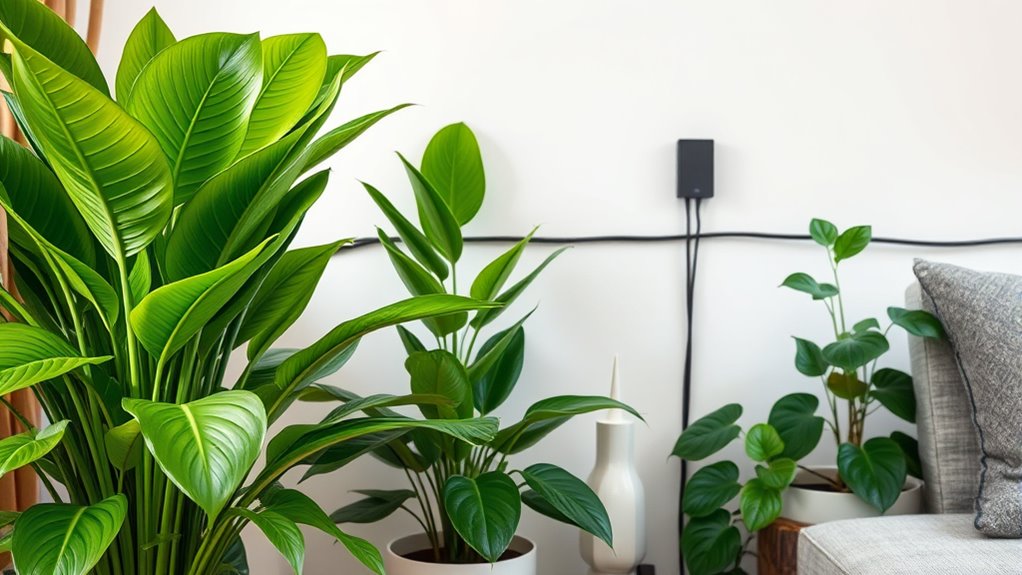
Using plants or decorative items to hide cables is a smart way to keep your space tidy. By strategically placing greenery or ornaments, you can conceal cords while adding visual interest. This approach not only improves cable management but also enhances your room’s overall decor. Additionally, incorporating visual organization techniques can further optimize your space and reduce clutter.
Strategic Plant Placement
Strategic plant placement offers an effective way to conceal cables and reduce clutter in your space. By integrating plants into your indoor gardening and furniture arrangement, you can hide cords behind foliage, making your area look tidy. Proper placement guarantees cables stay out of sight while maintaining accessibility. Consider these tips:
- Position tall plants near power outlets to hide cables behind leaves.
- Use potted plants to cover cords running along walls or furniture edges.
- Place decorative items or plants around your workspace to divert attention from wires.
- Arrange furniture so that cables run behind or underneath, with plants acting as natural screens.
- Incorporate digital platforms to discover innovative solutions for cable management and enhance your interior setup.
This approach not only improves aesthetics but also creates a calming environment by blending cable hiding into your interior design seamlessly.
Concealing Cords Creatively
Integrating decorative items and plants into your space offers a stylish way to hide cables and reduce visual clutter. Use cable concealment techniques like tucking cords behind lush foliage or placing decorative baskets and vases strategically to hide wiring. You can drape cords behind potted plants or weave them through the greenery for a seamless look. Incorporate decorative cord hiding by choosing items with built-in cable channels or hollow bases that hide cords out of sight. Positioning plants or decorative objects near power outlets not only conceals cables but also adds visual interest. For added safety and organization, consider using vacuum cleaners with specialized attachments that can help manage and keep cords tidy during cleaning. This creative approach keeps your space tidy without sacrificing style. With a little planning, you transform cables from an eyesore into an integrated part of your decor.
Enhancing Room Decor
Hiding cables behind plants or decorative items can instantly elevate your room’s aesthetic while keeping cords out of sight. Using wireless technology reduces the need for visible wires, and decorative covers can seamlessly blend cords into your decor. To enhance your space, consider these tips:
- Place plants or sculptures strategically to conceal cables and create a natural flow.
- Use decorative covers that match your room’s theme for a cohesive look.
- Position lamps or vases to hide power strips and charging cables.
- Incorporate wall-mounted planters with hidden compartments for cords, adding style and functionality.
- Educate yourself on regulatory compliance to ensure your cable management solutions meet safety standards and legal requirements.
These methods make your space look intentional and stylish while maintaining easy access to your devices. With a little creativity, your room becomes both beautiful and clutter-free.
Utilizing Under-Desk Cable Management Trays
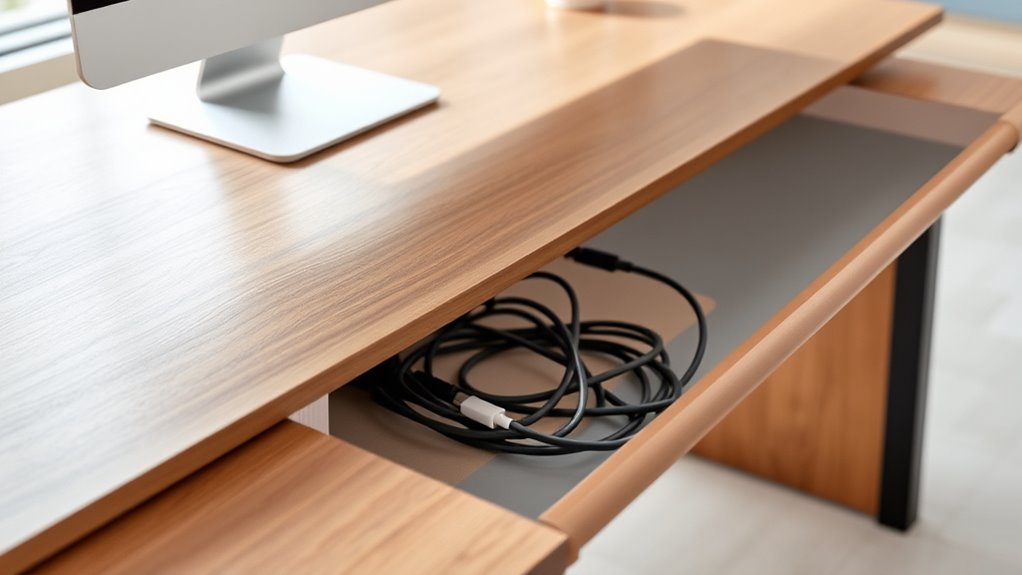
Under-desk cable management trays offer an effective solution for keeping your workspace tidy and organized. They help you conceal power strips and excess cords, making desk cable routing much simpler. By installing a tray beneath your desk, you can position your power strip securely, preventing it from cluttering your workspace or becoming a tripping hazard. This setup allows you to route cables neatly along the tray, reducing tangles and visual clutter. Choose a tray that fits your desk size and supports your cable volume. Once installed, you’ll find it easier to manage multiple devices, improve airflow, and maintain a clean, professional look. Under-desk trays are a practical, non-invasive way to streamline your cable setup without drilling holes. Additionally, selecting the right cable management solutions can further enhance organization and accessibility.
Employing Wireless Solutions to Minimize Cables
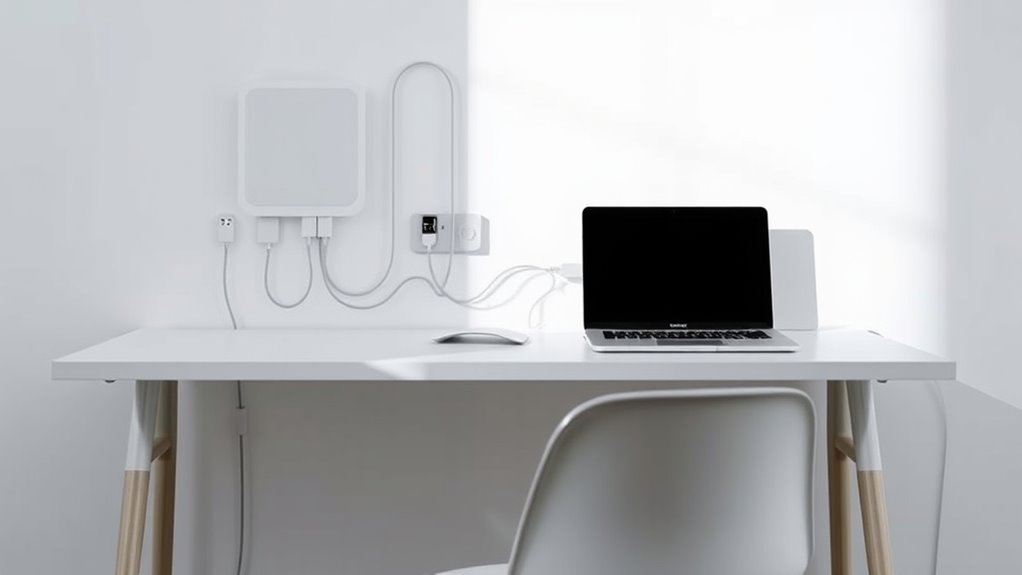
To markedly reduce cable clutter, consider switching to wireless devices whenever possible. Wireless charging eliminates the need for cords at your desk, keeping surfaces tidy. Bluetooth speakers free you from tangled audio cables, offering seamless sound without mess. Embracing these solutions simplifies your workspace and enhances mobility. Additionally, understanding privacy policies related to wireless devices helps you stay informed about data collection and security. Here are four ways to maximize wireless efficiency: 1. Use wireless charging pads for phones and gadgets. 2. Opt for Bluetooth speakers for audio playback without cords. 3. Connect wireless peripherals like keyboards and mice. 4. Streamline your setup with wireless printers and storage devices.
Frequently Asked Questions
Can Cable Management Methods Damage or Stain Walls or Furniture?
You might worry about wall damage or furniture stains when managing cables, but many safe methods exist. Using adhesive cable clips or cable sleeves typically won’t harm your walls or stain furniture if you apply them carefully and choose the right products. Avoid harsh glues or nails, and always follow instructions. This way, you can keep your space tidy without risking damage or stains on your walls or furniture.
How Do I Prevent Cables From Slipping or Falling With These Hiding Techniques?
Imagine your cables as delicate little snowflakes, ready to slip away. To prevent this, secure them with cable clips or adhesive hooks, ensuring they stay put and don’t fall. Use cable securing techniques like zip ties or velcro straps for added slip prevention, especially on longer runs. Double-check that cords are snug and properly anchored to avoid surprises, keeping your setup tidy and your cables safe from slipping or falling.
Are There Eco-Friendly or Sustainable Cable Management Options?
You can choose eco-friendly cable management options made from recyclable materials or biodegradable options. Look for products like bamboo cable clips or biodegradable cable sleeves that reduce environmental impact. These sustainable choices are durable and effective for hiding cords without harming the planet. By selecting environmentally conscious materials, you help promote sustainability while keeping your space tidy and organized.
What’S the Best Way to Manage Cables for Multiple Devices in Small Spaces?
When managing cables for multiple devices in small spaces, you want a clutter-free solution. Consider using wireless alternatives to reduce cords, and a cable organizer box to hide and organize your wires neatly. These options keep your space tidy without drilling holes, making installation easy and damage-free. You’ll enjoy a cleaner look and improved safety while keeping all your devices connected efficiently.
How Long-Lasting Are DIY Cable Covers Made From Fabric or Paper?
Durability determines your DIY cable cover’s dependability. Fabric covers often offer flexibility but may fray over time, while paper covers tend to tear easily, especially with daily wear. Your material’s longevity depends on the quality and usage. For lasting results, opt for sturdy, well-constructed options, and consider reinforcing weak spots. Regularly inspecting and maintaining your covers will ensure they stay secure, stylish, and super durable over time.
Conclusion
With these clever tips, you can master cable management without drilling holes—think of it as your modern-day scroll, keeping everything tidy and stylish. Whether you use cable sleeves, adhesive clips, or hidden behind furniture, you’ll create a sleek setup that even a Renaissance inventor would envy. So go ahead, channel your inner MacGyver, and enjoy a clutter-free space where cords stay out of sight and out of mind.


